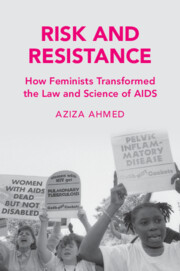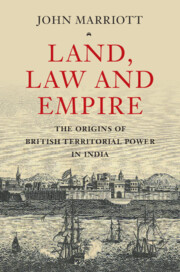Refine search
Actions for selected content:
1138 results
3 - ‘The Glory of their times’: Natural Philosophy, the Law, and the Spoils of Empire
-
- Book:
- The University of Cambridge in the Age of Atlantic Slavery
- Published online:
- 12 September 2025
- Print publication:
- 30 October 2025, pp 76-103
-
- Chapter
-
- You have access
- Open access
- HTML
- Export citation
Conclusion
-
- Book:
- Risk and Resistance
- Published online:
- 10 September 2025
- Print publication:
- 09 October 2025, pp 145-151
-
- Chapter
- Export citation
1 - Introduction
-
-
- Book:
- The Cambridge Handbook of One Health and the Law
- Print publication:
- 09 October 2025, pp 1-8
-
- Chapter
- Export citation
Introduction
-
- Book:
- Risk and Resistance
- Published online:
- 10 September 2025
- Print publication:
- 09 October 2025, pp 1-8
-
- Chapter
- Export citation
1 - “We Are Not Immune”
-
- Book:
- Risk and Resistance
- Published online:
- 10 September 2025
- Print publication:
- 09 October 2025, pp 9-32
-
- Chapter
- Export citation
2 - Litigating Risk
-
- Book:
- Risk and Resistance
- Published online:
- 10 September 2025
- Print publication:
- 09 October 2025, pp 33-60
-
- Chapter
- Export citation

The Cambridge Handbook of One Health and the Law
- Existing Frameworks, Intersections and Future Pathways
-
- Expected online publication date:
- September 2025
- Print publication:
- 09 October 2025
8 - Plurinational Juristocracy and Rights from Below at Bolivia’s Gas Frontier
-
-
- Book:
- Reckoning with Law in Excess
- Published online:
- 09 September 2025
- Print publication:
- 25 September 2025, pp 186-211
-
- Chapter
-
- You have access
- Open access
- HTML
- Export citation
11 - “A Dead Child Is Better than a Missing One”
-
-
- Book:
- Reckoning with Law in Excess
- Published online:
- 09 September 2025
- Print publication:
- 25 September 2025, pp 258-294
-
- Chapter
-
- You have access
- Open access
- HTML
- Export citation
Making Something Out of “Much Ado About Nothing”
- Part of
-
- Journal:
- Public Humanities / Volume 1 / 2025
- Published online by Cambridge University Press:
- 23 September 2025, e138
-
- Article
-
- You have access
- Open access
- HTML
- Export citation
Case 48: - Pyromania
- from Part 1: - Vignettes
-
- Book:
- Practise Psychiatry
- Published online:
- 04 September 2025
- Print publication:
- 18 September 2025, pp 401-404
-
- Chapter
- Export citation
Case 49: - Kleptomania
- from Part 1: - Vignettes
-
- Book:
- Practise Psychiatry
- Published online:
- 04 September 2025
- Print publication:
- 18 September 2025, pp 405-409
-
- Chapter
- Export citation
Chapter 3 - Testamentary Drama
-
- Book:
- The Will in English Renaissance Drama
- Published online:
- 04 September 2025
- Print publication:
- 18 September 2025, pp 100-129
-
- Chapter
- Export citation
Case 55: - Forensic Psychiatry
- from Part 1: - Vignettes
-
- Book:
- Practise Psychiatry
- Published online:
- 04 September 2025
- Print publication:
- 18 September 2025, pp 454-462
-
- Chapter
- Export citation
Social Justice in Hong Kong: Assessing the Role of Higher Education in Integrating Modern Social Justice Approaches into Legal Practice in the HKSAR
-
- Journal:
- Asian Journal of Law and Society , First View
- Published online by Cambridge University Press:
- 16 September 2025, pp. 1-21
-
- Article
-
- You have access
- Open access
- HTML
- Export citation
Mapping Out Juridified Conflicts over Mining: The Legal Cultures of the Subsoil Database
-
- Journal:
- Latin American Research Review ,
- Published online by Cambridge University Press:
- 15 September 2025, pp. 1-16
-
- Article
-
- You have access
- Open access
- HTML
- Export citation

Risk and Resistance
- How Feminists Transformed the Law and Science of AIDS
-
- Published online:
- 10 September 2025
- Print publication:
- 09 October 2025

Land Rights Now
- Global Voices on Indigenous Peoples and Land Justice
-
- Published online:
- 06 September 2025
- Print publication:
- 25 September 2025
-
- Book
-
- You have access
- Open access
- Export citation
The Nazi Financial Order: Banking Law and the Credit Supervisory Office in Germany and Austria
-
- Journal:
- Central European History , First View
- Published online by Cambridge University Press:
- 05 September 2025, pp. 1-27
-
- Article
-
- You have access
- Open access
- HTML
- Export citation

Land, Law and Empire
- The Origins of British Territorial Power in India
-
- Published online:
- 01 September 2025
- Print publication:
- 07 August 2025
